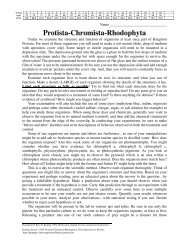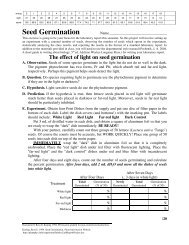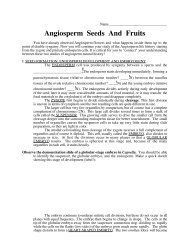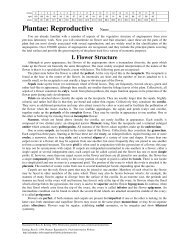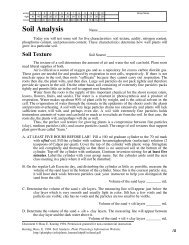Bryophytes
Bryophytes
Bryophytes
Create successful ePaper yourself
Turn your PDF publications into a flip-book with our unique Google optimized e-Paper software.
<strong>Bryophytes</strong><br />
Name _______________________________<br />
As you saw earlier, the algae are primarily aquatic; the few which do live on land are mostly<br />
unicellular or are simple filaments and usually occur in a habitat that is almost continuously moist.<br />
Except for floating forms, they are limited in their distribution within lakes, oceans, etc. by the depth<br />
to which enough light can penetrate to allow sufficient photosynthesis to maintain life and growth.<br />
Light is not such a limiting factor on land, but essentially all algae exposed for any length of time to<br />
the atmosphere desiccate and die.<br />
The simplest green plants which show a considerable degree of adaptation to a terrestrial<br />
environment are bryophytes. Today you will look at some of the diversity of plants which occur in<br />
this group and study the details of the life cycle of some representatives, try to see in what ways the<br />
plants are adapted to life in air and in what ways they fall short of being well-adapted land plants.<br />
A. LIVERWORTS (Hepatophyta)<br />
The majority of liverworts grow in moist, shady locations; a few are essentially aquatic. Two<br />
forms occur: thallose and leafy liverworts. Thallose liverworts consist of a flat, green, ribbon-like,<br />
dichotomously-branched thallus. This is very reminiscent of some algae; particularly Fucus. The<br />
thallus is anchored to the substrate by rhizoids arising from the lower surface. Leafy liverworts are<br />
also horizontal, but the thallus consists of “stems” bearing small “leaves” and rhizoids. The leafy<br />
liverworts are the more numerous, but they are so similar to some of the mosses in appearance that<br />
one is not always aware of how common they are.<br />
Observe the gross appearance of a representative of the thallose liverworts:Conocephalum.<br />
This plant is found quite commonly in our arboretum. Note the rhizoids and scales on the lower<br />
surface and the net-like pattern of chambers on the upper surface. A view with a dissection<br />
microscope should reveal the chimney in the center of each chamber with its pore.<br />
We will then prepare a gauntlet to show the reproductive biology of the thallose liverworts.<br />
Make a quick sketch of each part of the life history that is available...label everything that you can<br />
find.<br />
Marchantia thallus cs<br />
Marchantia cupule ls<br />
Page 1
Marchantia gemmae wm<br />
Marchantia antheridia ls<br />
Marchantia archegonium median ls<br />
Marchantia mature sporophyte median ls<br />
Conocephalum antheridia ls<br />
Conocephalum sporophyte ls<br />
Page 2
Leafy liverworts out-number thallose liverworts even though most textbooks only show<br />
Marchantia in any detail. Today we will prepare a short gauntlet of slides of Porella, a leafy<br />
liverwort as an example.<br />
Porella female branch wm<br />
Porella archegonia ls<br />
Porella male branch wm<br />
Porella antheridia ls<br />
Porella sporophyte ls<br />
Page 3
B. HORNWORTS (Anthocerophyta)<br />
The hornworts are a small phylum in which the body form is similar to that in the simplest<br />
thallose liverworts. It consists of a narrow, green, ribbon-like structure with essentially no internal<br />
differentiation. They are separated from the liverworts because of certain unusual characteristics of<br />
the sporophyte often considered to be advanced. These have an intercalary meristem at the base<br />
of the seta, are photosynthetic, and have guard cells. If living specimens of these rare plants are<br />
available (Anthoceros is most likely), your instructor may direct you a deeper investigation of these<br />
interesting plants. In any case we will prepare a gauntlet of a few prepared slides to see at least part<br />
of its life history. Label all your sketches completely!<br />
Anthoceros thallus cs (includes antheridium!) Anthoceros thallus wm<br />
Anthoceros sporophyte wm<br />
Anthoceros foot ls (seta and sporangium!)<br />
Anthoceros mature sporophyte cs<br />
Page 4
C. MOSSES (Bryophyta)<br />
Neither liverworts nor hornworts are as highly "vascularized" as advanced mosses, so we<br />
will expand our encounter with the mosses. The mosses include two groups--the true mosses (order<br />
Andreales and others) and the sphagnums (order Sphagnales).<br />
Observe the various freshly-collected specimens of mosses from our Arboretum. Some will<br />
be identified and other will probably not. The leafy green plants are gametophytes and any stalks<br />
with capsules at the tip of the leafy green plants are sporophytes. Also before we start another short<br />
gauntlet, you will want to observe your moss spore culture...I think it would be good to make a wet<br />
mount of some of that and include your own sketches below.<br />
Polytrichum protonema wm<br />
Polytrichum young gametophyte wm<br />
We will prepare a short gauntlet to examine stages in the life history of some true mosses.<br />
The genera from which most of the material will be taken are Mnium and Polytrichum. As you<br />
work today, you will want to illustrate the various stages in the life cycle of a moss, making sure to<br />
keep clear the relationships of the various stages to one another. Label all sketches completely!<br />
Moss protonema wm<br />
Polytrichum stem cs (leaf cs and stem cs!)<br />
Page 5
Mnium stem cs<br />
Mnium antheridia near-median ls<br />
Mnium female rosette ls (archegonium & egg)<br />
Mnium capsule ls<br />
Mnium capsule cs<br />
Page 6




